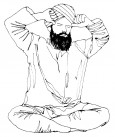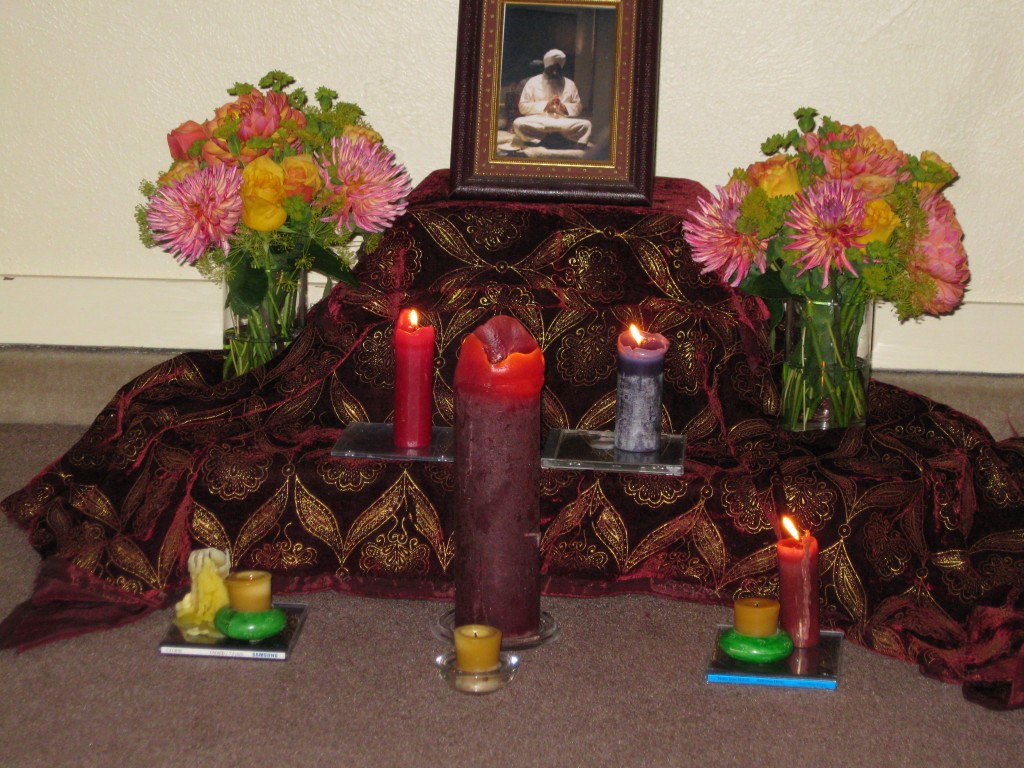How does Kundalini Yoga make me feel? Alive! My body feels vibrant and full of energy. My mind is clear as a diamond, and I’m awash with patience. My spirit glows and rejuvenates. I am blissful.
Tag Archive for Kundalini Yoga
Greetings and mantras
Greetings. Sat Nam.
The words that we tune in with in Kundalini Yoga classes are “Ong Namo Guru Dev Namo.” and the English translation is “Salutations or Greetings to the Divine within and without.” Since we used a lot of mantras in Kundalini Yoga, I also wanted to give you a little explanation about mantra.
Mantras are formulas that use the energy of sound to balance the brain, mind, chakras (energy centers that correlate with various parts of the body), and psyche (or soul mind). Mantra uses the creative projection of the mind to create balance of body, mind, and spirit.
Some questions I’ve been asked about mantras are:
- How do they work? Kundalini Yoga mantras elevate us through their sound vibration, meaning, and rhythmical repetition. Sometimes this is multiplied by linking the mantra to breath.
- Why aren’t they in English? Some mantras are in English. Two mantras that are in English are “I AM” and “GOD AND I, ME AND GOD ARE ONE.” (I know it isn’t grammatically correct but that’s the way it is written.) Yogi Bhajan said that he used mantras based on their technology of sound. Adi Shakti is a mantra that comes from Sanskrit:
Adi Shakti, namo, namo
Sarab shati, namo, namo
Pritam bhagvati, namo, namo
Kundalini, mata shakti, namo, namo.
It means:
I bow to the Primal Power.
I bow to the all Encompassing Power and Energy.
I bow to that through which God creates.
I bow to the creative power of the Kundalini, the Divine Mother Power.
Some Kundalini mantras come from the Sikh tradition such as “Guru Guru Wahe Guru.” It’s a mantra of ecstasy. “Wow, bliss!”
Other mantras come from the Kundalini Yoga tradition:
Sat Nam. It means truth is my identity or God is truth.
and Sa-ta-na-ma. It means Infinity, Life, Death (or transformation), Rebirth.
- Can’t I just use any word or affirmation? No, mantras are not affirmations and just any word will not have the effects of mantra on body, mind and spirit.
- My mind keeps thinking—”What am I going to wear tomorrow?” “What I’m going to have for dinner?” “Does my boyfriend like me?” Does this mean the mantra isn’t working? Aren’t I supposed to have an empty mind? No, Yogi Bhajan compared meditating to emptying the trash…all thoughts, desires, etc. need to pass through on their way to be dumped. He also compared it to taking a bath. We wouldn’t take one bath and say, “I’m clean. I don’t ever need to bathe again.” Meditation is cleansing the mind like a bath cleanses the body.
Mantra is a powerful technique to heal body, mind and spirit. Give it a try!
Yoga to Break Habits & Addictive Behavior

Here is the set I taught last week in my Kundalini Yoga Class and that I promised to put up on this blog.
This set was developed by Super Health. I found it in the 10/30/2012 “Kundalini Rising”, the 3HO international Kundalini Yoga Association Newsletter. It was contributed by Mukta Kaur Khalsa, author of “Meditations for Addictive Behavior.”
SuperHealth is a highly specialized technology that helps people move from recovery to self-discovery. You can learn more about SuperHealth and find more tools and information about Breaking Addictive Behaviors at their website: http://www.super-health.net.
Note Re the Music: You can find the music mentioned in this set at SikhNet http://www.sikhnet.com or Spirit Voyage http://www.spiritvoyage.com. SikhNet may be free or by donation. I’m not sure since I haven’t yet used SikhNet for this. Spirit Voyage is by fee and you can buy CD’s or download albums or particular selections. They have a free Mantrapedia that lists lots of mantras, their meaning, uses, etc. along with all the albums that have each selection.
Note Re Nirinjan: There are two Nirinjans with amazing ethereal voices. The Nirinjan talked about in this class is Nirinjan Kaur Khalsa from Espanola–not the one from Vancouver, Canada.
1)Tune In – Ong Namo Guru Dev Namo
2)Do Warm-Ups
3) The Kriya: The “4 U” kriya sets the nervous system to withstand pressures of society and challenges of times. Do each posture for 11 minutes for 11 days without moving a muscle and this is said to create nerves strong as steel – “stainless steel forever.” This kriya also works on eliminating fear and developing greater spinal flexibility.
Framing: Different people in class will function at individual levels of development and capability. Therefore, though the full time for each posture is 11 minutes, allow people to stop at 3 minutes, 6 minutes and full 11 minutes according to their individual ability. Those who stop before 11 minutes can simply rest until it is time for the next posture.
Explain: Each person to access his/her own level of capability without straining himself including those with medical limitations.
Suggested Music: As stated by Yogi Bhajan, “Nirinjan Kaur’s voice is from the heart. The sound on the listener has a profound affect. When the vibration hits the eardrum it stimulates the hypothalamus which triggers the pituitary and pineal glands. This in essence has an ‘awakening experience on the listener’ to the higher center of consciousness.” Coupled with Yogi Bhajan’s poetry in the suggested music below, this music gives the practitioner an enhanced experience.
a) The first “U Shape” posture: Lie on the back, raise both legs and arms 90 degrees. Encourage students to set the pose and hold it without moving. Suggested music: Bountiful, Blissful and Beautiful by Nirinjan Kaur.
After 3 minutes, ask those who wish to stop to inhale, hold, exhale. Repeat 3 times then relax. Encourage everyone else to continue the posture and everyone can sing aloud. Also encourage to use breath as a tool to help; can do long deep breathing or breath of fire to help maintain the posture, help quiet the mind and give energy.
At 6 minutes, again ask those who will stop at this point to inhale, hold, exhale. Repeat 3 times, then relax. Encourage everyone else to continue the posture and everyone can sing aloud. Also encourage to use breath as a tool to help; can do long deep breathing or breath of fire to help maintain the posture, help quiet the mind and give energy.
After 11 minutes, inhale, hold, exhale. Repeat 3 times, then, relax.
b) Second “U Shape” posture: Remain on the back, legs overhead like plough pose however toes not touching the ground. This creates a “U” shape. Arms overhead toward the toes. If support is needed, the student can brace his/her back
with hands so as not to create a strain.
See Posture # 1 and repeat same 3 minutes, 6 minutes and full 11 minutes. Suggested music: Say Saraswati by Nirinjan Kaur
c) Third “U Shape” posture: Sit up with legs extended in front and arms straight out at heart level. Repeat 3, 6 and 11 minutes intervals. Suggested music: Humee Hum Brahm Hum by Nirinjan Kaur.
d) Fourth “U Shape” posture: Stand up and bend forward with hands pointing toward the toes. Back is straight and head is flat (not tipped back) to create a “U” shape. Repeat 3, 6 and 11 minute intervals. Suggested music: Heal Me by Nirinjan Kaur.
4 ) Completely relax on the back. Guided relaxation through every nerve and muscle of the body beginning at toes through crown and top of the head. Suggestion music: Guru Ram Das by Snatam Kaur. 15 minutes.
Entire Set: 1 hour
5) Meditation: Habituation Meditation:
Make fists and press the thumbs on the indentations of the temples. Lock the back molars together with closed mouth. Focus the eyes between the eyebrows. Breathe normally. Silently repeat ‘Sa Ta Na Ma.’ On each sound vibrate the jaw muscles by pressing the molars together and releasing. As you press you will feel a movement at the temples.
This meditation is known to break the persistence of substance abuse. It triggers a reflex in the brain and affects the pituitary and pineal gland known to recalibrate addictive patterning.
Begin with 5 – 7 minutes and gradually work up to 31 minutes for 40 days to break a habit.
6) End: Long Time Sunshine Song
7) Prayer
This set was shared by:
Mukta Kaur Khalsa, Ph.D., is the Director of SuperHealth and personally studied the teachings for addictive behaviors with Yogi Bhajan beginning in 1973. She directed a specialized rehabilitation hospital in Tucson, AZ, which was rated in the top 10% of all residential programs in the US by the Joint Commission on Accreditation of Healthcare Organizations. Mukta directed a pilot program in collaboration with the Punjab government in India and is co-author of a recently published research manuscript on the results of the India program. Mukta is the 3HO UN Special Representative to the Office of Drug Control and Crime, Vienna, Austria for the 3HO Foundation and conducts trainings on SuperHealth technology for healthcare professionals, yoga teachers and students, and people seeking a new and healthy lifestyle. Mukta is author of “Meditations for Addictive Behavior” and lives in Espanola, New Mexico.
SuperHealth is on the cutting-edge of behavioral health and addiction therapy. It is not filled with fads and gimmicks nor is it a quick fix or “talk therapy” approach. A proven and precise yogic technology, the experience rebuilds the nervous and glandular systems, recalibrates the imprint of addictive patterning on the brain, and inspires and uplifts the human spirit. The neuron patterns of the brain must be changed to affect addictive behavior. A person cannot change and sustain the change until his awareness or consciousness has been heightened.
Consisting of Kundalini Yoga, meditation, and nutrition restoration, the SuperHealth program is helpful for anyone whose well-being has been compromised by drugs, alcohol, food issues, smoking, co-dependency, depression, stress or information overload. An overtaxed nervous system can leave you vulnerable to temptations and urges, fatigue, anxiety and disconnection from your intuition and sense of completeness within.


